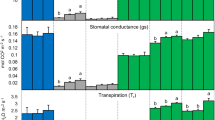Summary
A detailed scheme of carboxylate formation and retention by plant tissues as a result of ion uptake and utilization is given.
By means of discontinuities in the supply with nutrient ions, carboxylate retention by the tissues of perennial ryegrass was followed as a function of growth. It was found that translocation of potassium nitrate to the shoot and subsequent nitrate metabolism was the only process capable of supplying the shoot with sufficient carboxylates and of removing the excess from the foliage to the root system with maintenance of the normal carboxylate content. Absorbed bicarbonate was a good source of carboxylates in the roots, but the rate of translocation to the plant tops was too slow relative to growth. Therefore, the carboxylate concentration in the foliage fell progressively to one half the normal value.
Constancy of carboxylate concentration in the dry matter was related to the early establishment of the proportion of carboxylates to dry material in the new growth, making it independent of subsequent changes in water content of the tissues.
Changes in carboxylate concentrations due to changes in the supply were continuous with time. Nitrate caused a depression in the roots during nitrate accumulation, but the nitrate metabolism in the follage made sufficient carboxylates available for replenishment and maintenance of their normal level in the whole plant.
Similar content being viewed by others
References
Bedri, A. A., Wallace, A. and Rhoads, W. A., Assimilation of bicarbonate by roots of different plant species. Soil Sci.89, 257–263 (1960).
Bollard, E. G., Nitrogenous components in plant xylem sap. Nature178, 1189–1190 (1956).
Bollard, E. G., Nitrogen metabolism of apple trees. Nature171, 571 (1953).
Bowling, D. J. F. and Weatherley, P. E., The relationship between transpiration and potassium uptake in Ricinus communis. J. Exp. Botany16, 732–741 (1965).
Dijkshoorn, W., Metabolic regulation of the alkaline effect of nitrate utilization in plants. Nature194, 165–167 (1962).
Dijkshoorn, W., Le bilan ionique dans le diagnostic foliaire. Jaarb. Inst. Biol. Scheik. Onderz.1964, 133–144 (1964).
Dijkshoorn, W. and Wijk van, A. L., The sulphur requirements as evidenced by the sulphur: nitrogen ratio in the organic substance of plants. A review of published data. Plant and Soil26, 129–157 (1967).
Hoad, G. V. and Peel, A. J., Studies on the movement of solutes between the tubes and surrounding tissues in willow I. Interference between solutes and rate of translocation measurements. J. Exp. Botany16, 433–431 (1965).
Hurd, R. G., The effect of pH and bicarbonate ions on the uptake of salts by discs of red beets. J. Exp. Botany9, 159–174 (1958).
Hurd, R. G., An effect of pH and bicarbonate on salt accumulation by discs of storage tissue. J. Exp. Botany10, 345–358 (1959).
Hurd, R. G. and Sutcliffe, J. F., An effect of pH on the uptake of salts by plant cells. Nature180, 233–235 (1957).
Hurd-Karrer, A. M., Hydrogen ion concentration of leaf juice in relation to environment and plant species. Am. J. Botany26, 834–846 (1939).
Jacobsen, L., Carbon dioxide fixation and ion absorption in barley roots. Plant Physiol.30, 264–269 (1955).
Johnson, R. E., Jackson, P. C. and Adams, H. R., Changes in malate and citrate concentration of barley roots during salt absorption. Plant Physiol.38, xxv (1963).
Lundegårdh, H., Absorption, transport and exudation of inorganic ions by the roots. Ark. Botan.32 A, nr. 12, 1–139 (1945).
MacDonald, I. R. and Laties, G. G., A comparative study of the influence of salt type and concentration on14CO2 fixation in potato slices at 25°C and 0°C. J. Exp. Botany15, 530–537 (1964).
Peel, A. J. and Weatherley, P. E., Composition of sieve tube sap. Nature184, 1955–1966 (1959).
Poole, R. J. and Poel, W. L., Carbon dioxide and pH in relation to salt uptake by beetroot tissue. J. Exp. Botany16, 453–461 (1965).
Rhoads, W. A. and Wallace, A., Possible involvement of dark fixation of CO2 in lime-induced chlorosis. Soil Sci.89, 248–256 (1960).
Splittstoesser, W. E. and Beevers, H., Acids in storage tissues. Effects of salts and aging. Plant Physiol.39, 163–169 (1964).
Tuil, H. D. W. van, Organic salts in plants in relation to nutrition and growth. Agr. Research Rept. (Wageningen)657, 1–83 (1965).
Tuil, H. D. W. van, Lampe, J. E. M. and Dijkshoorn, W., The possibility of relating the ash-alkalinity to the organic salt content. Jaarb. Inst. Biol. Scheik. Onderz.1964, 157–160 (1964).
Ulrich, A., Metabolism of organic acids in excised barley roots as influenced by temperature, oxygen tension and salt concentration. Am. J. Botany29, 220–227 (1942).
Wit, C. T. de, Dijkshoorn, W. and Noggle, J. C., Ionic balance and growth of plants. Versl. Landbouwk. Onderz. (Wageningen)69.15 (1963).
Author information
Authors and Affiliations
Additional information
Agronomy Department, Paper No. 787
Rights and permissions
About this article
Cite this article
Dijkshoorn, W., Lathwell, D.J. & De Wit, C.T. Temporal changes in carboxylate content of ryegrass with stepwise change in nutrition. Plant Soil 29, 369–390 (1968). https://doi.org/10.1007/BF01348971
Received:
Issue Date:
DOI: https://doi.org/10.1007/BF01348971




